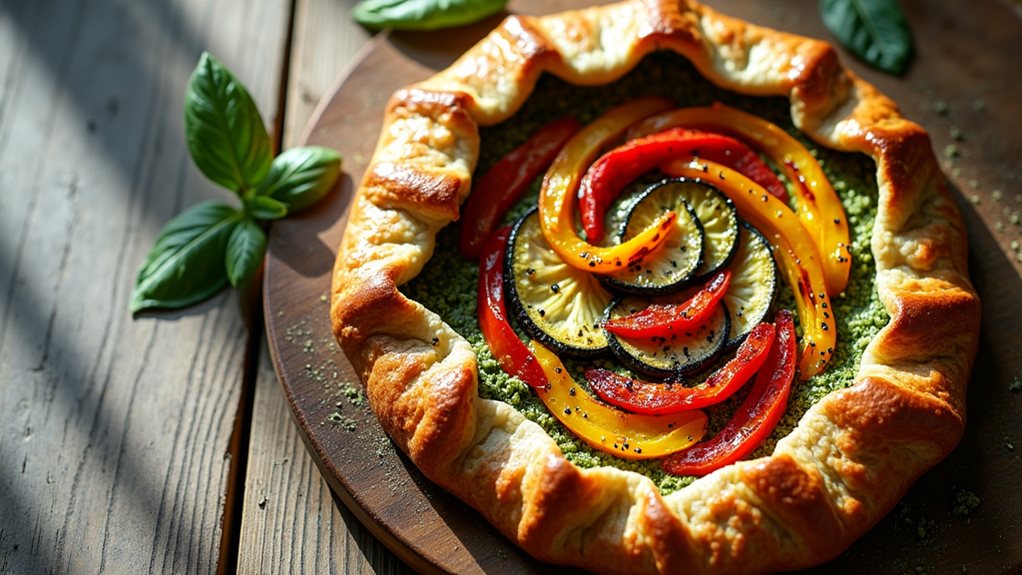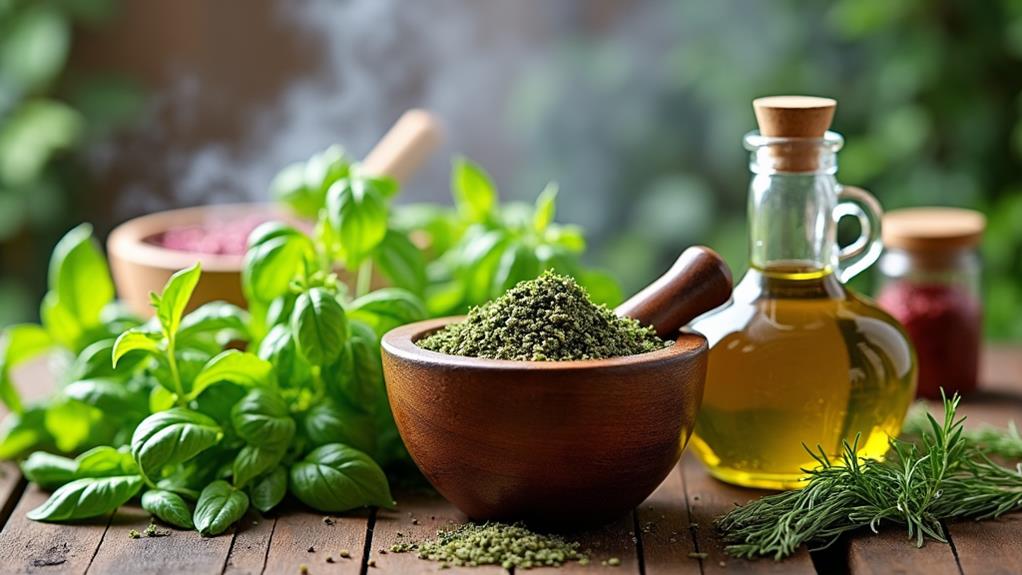You'll find that a Roasted Vegetable Galette with Pesto offers a perfect blend of rustic charm and culinary sophistication. This French-inspired dish transforms simple ingredients into an impressive presentation, combining flaky pastry with caramelized vegetables and aromatic pesto. While it may look intimidating at first glance, you'll be surprised by how easily you can master this versatile recipe, which welcomes both seasonal produce and creative variations. Let's explore the origins and techniques behind this elegant yet approachable dish.
Key Takeaways
- Galette combines flaky pie crust with roasted zucchini, bell peppers, and pesto for a rustic French tart that's both elegant and approachable.
- Preheat oven to 400°F and slice vegetables thinly, tossing with olive oil and salt before arranging on store-bought pie crust.
- Spread pesto on crust before adding vegetables, then fold edges over to create a rustic border and brush with egg wash.
- Bake until crust is golden brown and vegetables are tender, ensuring proper moisture control to maintain crust texture.
- Serve warm or at room temperature, garnished with fresh herbs, and store leftovers in the refrigerator for several days.
History
While the exact origins of the galette remain somewhat unclear, this rustic French pastry emerged from humble beginnings in the medieval period, when home cooks needed a practical way to create free-form tarts without specialized baking equipment.
You'll find that galettes have evolved significantly over centuries, moving from simple peasant fare to their current status as versatile culinary canvas.
They've traditionally been made with whatever ingredients were seasonally available, from sweet fruit fillings to savory meat and vegetable combinations.
The word "galette" itself comes from the Norman word "gale," meaning flat cake, and you'll notice that the defining characteristic has always been its casual, rustic appearance.
Today's interpretation with roasted vegetables and pesto represents a modern twist on this time-honored tradition.
Recipe
This rustic French-inspired galette combines the simplicity of store-bought pie crust with seasonal vegetables and aromatic pesto. The free-form nature of this tart means perfection isn't necessary – its charm lies in its casual, homemade appearance.
The combination of roasted zucchini and bell peppers creates a colorful and flavorful filling, while the pesto adds depth and herbaceous notes. The flaky crust wraps around the filling to create a beautiful presentation that's both elegant and approachable.
- 1 prepared pie crust (14-inch/35cm diameter)
- 2 medium zucchini (2 cups/300g), sliced
- 2 bell peppers (2 cups/300g), sliced
- 1/2 cup (120g) store-bought pesto
- 2 tablespoons (30ml) olive oil
- Salt and pepper to taste
Preheat oven to 400°F (200°C). Toss sliced zucchini and bell peppers with olive oil, salt, and pepper. Spread vegetables on a baking sheet and roast for 15 minutes until slightly softened.
Meanwhile, roll out pie crust on a parchment-lined baking sheet. Spread pesto over the crust, leaving a 2-inch border. Once vegetables are roasted, let them cool slightly, then arrange them in a circular pattern over the pesto.
Fold the edges of the dough over to create a rustic border. Bake for 25-30 minutes until the crust is golden brown.
For optimal results, ensure the roasted vegetables have cooled slightly before assembling the galette to prevent excess moisture from making the crust soggy. The bottom crust can be made crispier by preheating the baking sheet before adding the assembled galette.
Store leftovers in an airtight container in the refrigerator for up to 2 days, and reheat in a 350°F (175°C) oven for 10 minutes to restore crispness.
Cooking Steps
You'll want to start by preheating your baking sheet in the oven and slicing your zucchini and peppers into uniform, thin rounds that'll cook evenly.
After seasoning your vegetables with salt and arranging them in a pleasing pattern on the pesto-covered crust, fold the edges of the dough over to create a rustic border.
Before sliding your galette into the oven, don't forget to brush the exposed crust with an egg wash, which will give you that appetizing golden-brown finish.
Step 1. Preheat Baking Surface First

For perfectly crispy galette crust, preheating your baking surface stands as an essential first step in the preparation process.
Place your baking sheet or pizza stone in the oven while it's heating to 400°F (200°C), allowing at least 15 minutes for the surface to reach optimal temperature.
When you're ready to bake, carefully transfer your assembled galette onto the preheated surface.
You'll want to use parchment paper for easy sliding and to prevent sticking.
This technique ensures that the bottom crust begins cooking immediately upon contact, creating a barrier that prevents moisture from the vegetables from seeping in.
The result is a wonderfully crispy, golden-brown bottom that'll hold up to the weight of your roasted vegetables and pesto filling.
Step 2. Slice Vegetables Into Thin Rounds

Carefully slicing vegetables into uniform, thin rounds creates the foundation for a beautifully layered galette that cooks evenly and delivers balanced flavor in every bite.
Using a sharp knife or mandoline, cut your zucchini and bell peppers into slices approximately 1/8-inch thick, maintaining consistent thickness throughout.
You'll want to position your knife at a slight angle when slicing the zucchini to create oval-shaped pieces that'll layer more effectively.
For the bell peppers, remove the core and seeds first, then slice them into rings of similar width.
If you're using a mandoline, keep your fingers safe by using the guard, especially as you near the end of each vegetable.
These precisely cut pieces won't only cook uniformly but also create an attractive spiral pattern when arranged on your galette.
Step 3. Season Vegetables With Salt
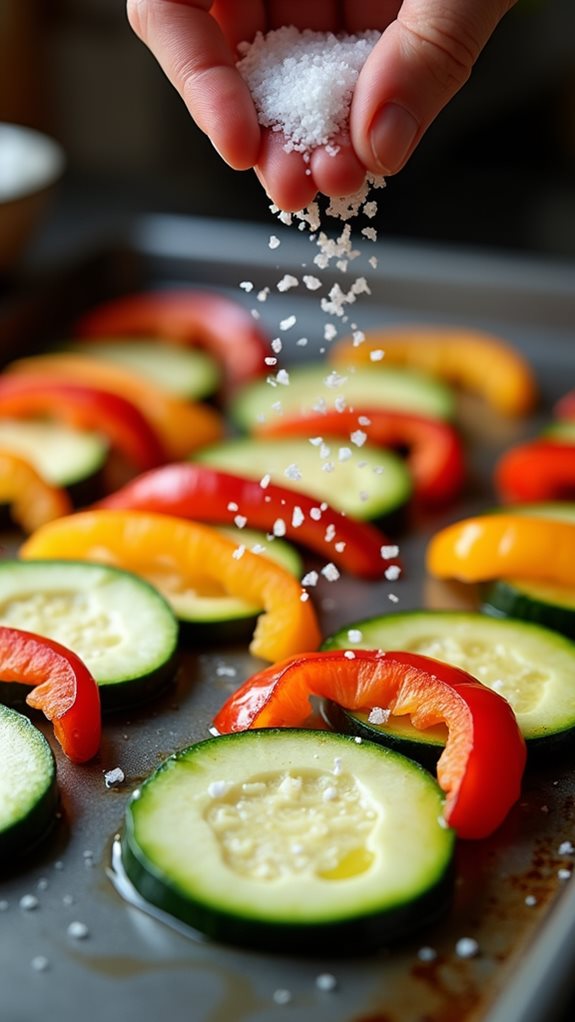
Proper salting transforms ordinary roasted vegetables into flavorful components that'll elevate your galette from good to exceptional.
Once you've sliced your zucchini and bell peppers, sprinkle them generously with kosher salt, using about 1/2 teaspoon per pound of vegetables. You'll want to salt the vegetables before adding the olive oil, as this allows the salt to directly contact the vegetable surfaces.
Let the salted vegetables rest for 5-10 minutes before roasting, which allows the salt to draw out excess moisture and concentrate their flavors.
Don't worry about over-salting at this stage, as some salt will be lost with the extracted liquid. Before arranging the roasted vegetables on your galette, taste a piece and adjust the seasoning if needed.
Step 4. Fold Edges Over Vegetables
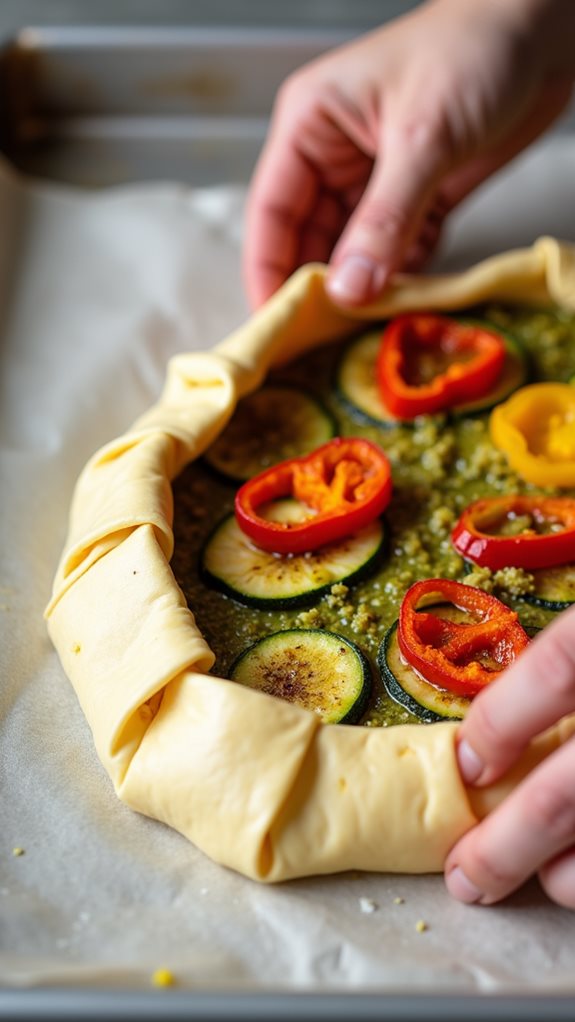
Once your vegetables are perfectly arranged on the pesto-covered dough, creating the distinctive galette shape requires folding the exposed edges of the pastry up and over the filling.
Working your way around the circle, lift each section of the dough's border and gently fold it over the vegetables, creating pleats as you go to accommodate the round shape. You'll want to press each fold lightly to ensure it stays in place during baking.
Make sure you're leaving the center of the galette open, as this rustic tart's charm comes from its free-form nature and visible filling.
The folded edges should overlap slightly at each pleat, creating a secure barrier that will prevent any filling from leaking during baking while achieving that characteristic galette appearance.
Step 5. Brush Crust With Egg Wash
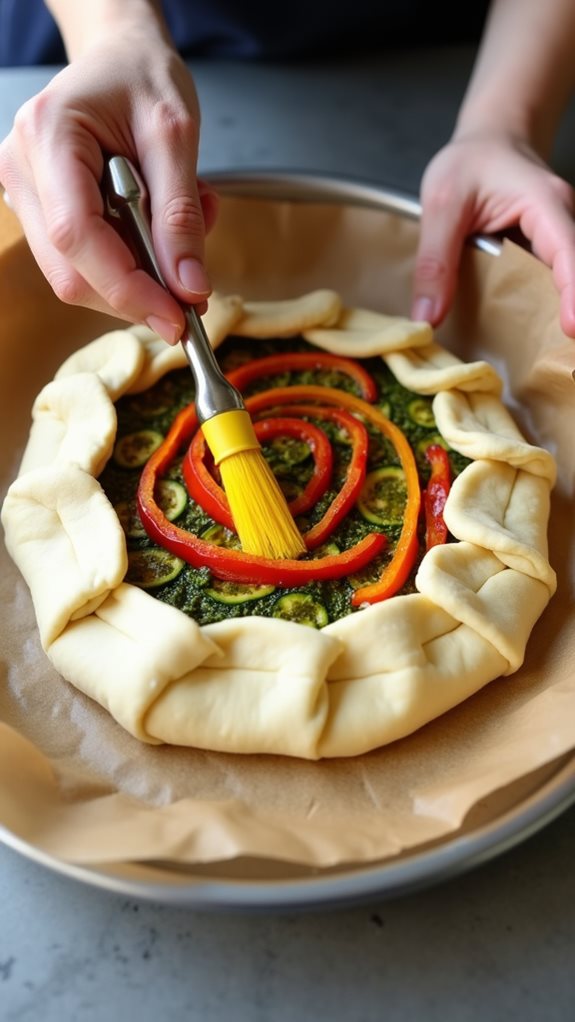
The final touch before baking your galette involves brushing the folded crust with an egg wash, which creates a beautiful golden-brown sheen and adds professional polish to your finished pastry.
To prepare the egg wash, whisk one large egg with a tablespoon of water until well combined.
Using a pastry brush, gently apply the mixture to the exposed crust, making sure to cover all the folded edges evenly.
Don't forget to get into the creases where the dough overlaps, as these areas can sometimes be missed.
If you notice any excess egg wash pooling at the base of the crust, carefully dab it away with a paper towel to prevent soggy spots from forming during baking.
Final Thoughts
Whether you're a seasoned baker or new to pastry-making, this roasted vegetable galette offers a delightful way to showcase seasonal produce while mastering the art of rustic French baking.
You'll find that this five-ingredient version simplifies the traditional recipe without compromising its elegant presentation or satisfying flavors.
Don't hesitate to experiment with different vegetable combinations based on what's available in your garden or local market. The beauty of a galette lies in its forgiving nature – slight imperfections in the folded edges only add to its rustic charm.
Remember that while the recipe calls for zucchini and bell peppers, you can substitute other vegetables like eggplant, tomatoes, or mushrooms. Just be sure to roast them properly to avoid excess moisture that could affect the crust's texture.
[DIRECTIONS]:

